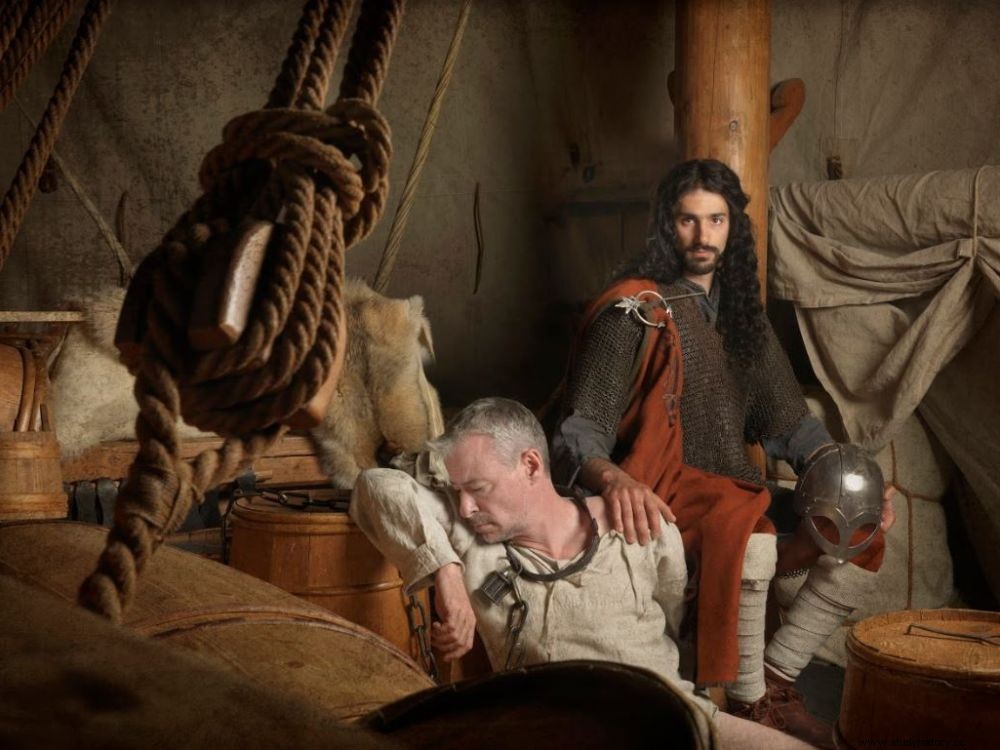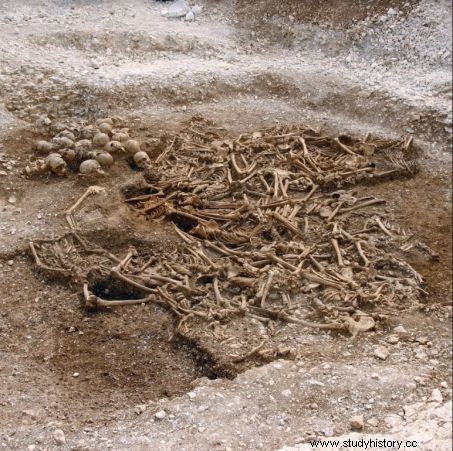The largest DNA analysis of Viking skeletons ever conducted reveals that these mythical warriors were not all Norse.

Viking world (8th-10th century) and gene flow:artistic reconstruction presenting a Viking warrior and his slave.
Blond giants cut like athletes, the knife between the teeth, going up the rivers with boats with heads of dragon... Bloodthirsty predators putting towns and countrysides to fire and blood... The Vikings, coming from Scandinavia, were traditionally described as having swept over Europe for more than two hundred years, between the 8th and 10th centuries. However, excessively caricatured by cinema and TV series, a certain fiction has taken precedence over reality, and it has become difficult to get a real idea of who these men and women were, mentioned at the same time. like warriors, sailors, adventurers, traders, looters, as much as slavers…
Hundreds of skeletons from Viking Age burial grounds
This return to reality is what a new analysis published on September 16, 2020 in the journal Nature - one of the largest ever made in the world - has just been made in the light of the most recent discoveries. According to its numerous co-authors (90), the sequencing of the ancient DNA of several hundred human skeletons (men, women, children) collected from various sites and necropolises from the Viking era in Ukraine, United Kingdom, Scandinavia, Poland, Russia and as far as Greenland, could partly rewrite the history of these northern invaders, whose original geographical area has always been located between Norway, Sweden, Denmark and Finland. But did all the "vikings" really come from these regions? And could the genetic manifestations of their migrations be distinguished?
 People of navigators, between the 8th and 10th centuries, the Vikings sailed the seas of the Russia to America. Credits:Werner Karrasch / The Viking Ship Museum in Roskilde
People of navigators, between the 8th and 10th centuries, the Vikings sailed the seas of the Russia to America. Credits:Werner Karrasch / The Viking Ship Museum in Roskilde
"Viking identity was not limited to people of Scandinavian genetic ancestry "
After six years of intense research led by renowned paleogeneticist Eske Willerslev, director of the GLOBE Institute and the Lundbeck Foundation GeoGenetics Center at the University of Copenhagen (Denmark), the answers are illuminating:"The identity viking was not limited to people of scandinavian genetic ancestry ".
For Vincent Carpentier, archaeologist from the National Institute for Preventive Archaeological Research (Inrap), specialist in the Viking period, "by these analyses, the myths and images of Epinal associated with the Vikings and the ethnic divisions of the early Middle Ages are here revisited and challenged". What these pioneering results demonstrate, in fact, is that the Vikings already conveyed, like all European populations, traits linked to their more or less distant ancestry in time and space, from the peasant of the time Neolithic period from the plains of the Danube, to the slaves brought back during their raids.
"Njall le Brûlé" with dull complexion and dark hair
So many traces present in their genes, migrations and exchanges that occurred before and during the Viking era. "Genetics also attest that they were far from all tall, blond, blue-eyed guys! The Viking world is more heterogeneous" , explains Ludovic Orlando, paleogeneticist, director of the Molecular Anthropobiology and Synthetic Imaging Laboratory (Amis), at the University of Toulouse III-Paul Sabatier, one of the main co-signatories of the study, joined by Sciences et Future . Browns or redheads were present among them. "One of the greatest heroes of the Icelandic sagas (13 e century), was he not a certain "Njall le Brûlé", because of his dull complexion and dark hair?" , asks Vincent Carpentier in turn. What this vast survey depicts is that other island or coastal populations of northern Europe took part in the Viking expeditions. "Picts, Orcadians, Balts, Anglo-Saxons got involved ", specifies Vincent Carpentier, also a researcher at the Craham Center for Ancient and Medieval Archaeological and Historical Research (University of Caen Normandy).
 Mass grave of around 50 decapitated Vikings found at a site in Dorset, UK. Credits:Dorset County Council / Oxford Archaeology
Mass grave of around 50 decapitated Vikings found at a site in Dorset, UK. Credits:Dorset County Council / Oxford Archaeology
This genetic analysis reveals, for example, that two skeletons from Viking burial sites in Scotland turned out to be those of local populations who were buried in the manner of the Vikings, after having adopted some of their habits and customs - in particular, being buried with Viking swords - without, however, having intermingled genetically with the Norse. Similarly, warriors who fought and perished together turn out to have a greater genetic complexity among them than we thought.
"Proof that in addition to blood ties, it was culture that united all these populations ", adds Ludovic Orlando. We know that during the second half of the 9 e century Viking fighters recruited wide! "In Normandy, for example, many Vikings in Rollo's army did not come from Scandinavia, but from Anglo-Saxon England, Ireland, Scotland" , adds the historian. "There has actually been a gigantic mixing of individuals and genes, between the Arctic and the Mediterranean, and from Russia to North America ", continues the expert. A crossbreeding which, from the Baltic to Russia, united, in the Viking period, northern Europe to central Asia. A genetic diversity of the ancient Scandinavians and their complex relationships with their neighbors that reveals this prolix paleogenetic analysis. Enough to update some history books, believes Eske Willerslev.
